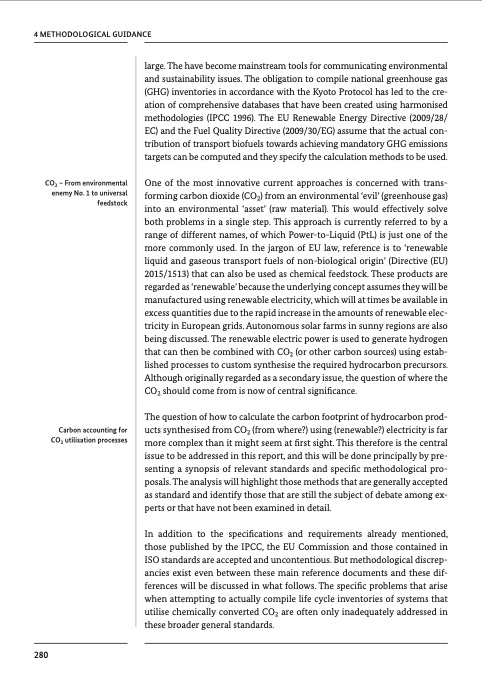
PDF Publication Title:
Text from PDF Page: 283
4 METHODOLOGICAL GUIDANCE CO2 – From environmental enemy No. 1 to universal feedstock large. The have become mainstream tools for communicating environmental and sustainability issues. The obligation to compile national greenhouse gas (GHG) inventories in accordance with the Kyoto Protocol has led to the cre- ation of comprehensive databases that have been created using harmonised methodologies (IPCC 1996). The EU Renewable Energy Directive (2009/28/ EC) and the Fuel Quality Directive (2009/30/EG) assume that the actual con- tribution of transport biofuels towards achieving mandatory GHG emissions targets can be computed and they specify the calculation methods to be used. One of the most innovative current approaches is concerned with trans- forming carbon dioxide (CO2) from an environmental ‘evil’ (greenhouse gas) into an environmental ‘asset’ (raw material). This would effectively solve both problems in a single step. This approach is currently referred to by a range of different names, of which Power-to-Liquid (PtL) is just one of the more commonly used. In the jargon of EU law, reference is to ‘renewable liquid and gaseous transport fuels of non-biological origin’ (Directive (EU) 2015/1513) that can also be used as chemical feedstock. These products are regarded as ‘renewable’ because the underlying concept assumes they will be manufactured using renewable electricity, which will at times be available in excess quantities due to the rapid increase in the amounts of renewable elec- tricity in European grids. Autonomous solar farms in sunny regions are also being discussed. The renewable electric power is used to generate hydrogen that can then be combined with CO2 (or other carbon sources) using estab- lished processes to custom synthesise the required hydrocarbon precursors. Although originally regarded as a secondary issue, the question of where the CO2 should come from is now of central significance. The question of how to calculate the carbon footprint of hydrocarbon prod- ucts synthesised from CO2 (from where?) using (renewable?) electricity is far more complex than it might seem at first sight. This therefore is the central issue to be addressed in this report, and this will be done principally by pre- senting a synopsis of relevant standards and specific methodological pro- posals. The analysis will highlight those methods that are generally accepted as standard and identify those that are still the subject of debate among ex- perts or that have not been examined in detail. In addition to the specifications and requirements already mentioned, those published by the IPCC, the EU Commission and those contained in ISO standards are accepted and uncontentious. But methodological discrep- ancies exist even between these main reference documents and these dif- ferences will be discussed in what follows. The specific problems that arise when attempting to actually compile life cycle inventories of systems that utilise chemically converted CO2 are often only inadequately addressed in these broader general standards. Carbon accounting for CO2 utilisation processes 280PDF Image | Chemical Processes and Use of CO2

PDF Search Title:
Chemical Processes and Use of CO2Original File Name Searched:
CO2_Buch_engl.pdfDIY PDF Search: Google It | Yahoo | Bing
NFT (Non Fungible Token): Buy our tech, design, development or system NFT and become part of our tech NFT network... More Info
IT XR Project Redstone NFT Available for Sale: NFT for high tech turbine design with one part 3D printed counter-rotating energy turbine. Be part of the future with this NFT. Can be bought and sold but only one design NFT exists. Royalties go to the developer (Infinity) to keep enhancing design and applications... More Info
Infinity Turbine IT XR Project Redstone Design: NFT for sale... NFT for high tech turbine design with one part 3D printed counter-rotating energy turbine. Includes all rights to this turbine design, including license for Fluid Handling Block I and II for the turbine assembly and housing. The NFT includes the blueprints (cad/cam), revenue streams, and all future development of the IT XR Project Redstone... More Info
Infinity Turbine ROT Radial Outflow Turbine 24 Design and Worldwide Rights: NFT for sale... NFT for the ROT 24 energy turbine. Be part of the future with this NFT. This design can be bought and sold but only one design NFT exists. You may manufacture the unit, or get the revenues from its sale from Infinity Turbine. Royalties go to the developer (Infinity) to keep enhancing design and applications... More Info
Infinity Supercritical CO2 10 Liter Extractor Design and Worldwide Rights: The Infinity Supercritical 10L CO2 extractor is for botanical oil extraction, which is rich in terpenes and can produce shelf ready full spectrum oil. With over 5 years of development, this industry leader mature extractor machine has been sold since 2015 and is part of many profitable businesses. The process can also be used for electrowinning, e-waste recycling, and lithium battery recycling, gold mining electronic wastes, precious metals. CO2 can also be used in a reverse fuel cell with nafion to make a gas-to-liquids fuel, such as methanol, ethanol and butanol or ethylene. Supercritical CO2 has also been used for treating nafion to make it more effective catalyst. This NFT is for the purchase of worldwide rights which includes the design. More Info
NFT (Non Fungible Token): Buy our tech, design, development or system NFT and become part of our tech NFT network... More Info
Infinity Turbine Products: Special for this month, any plans are $10,000 for complete Cad/Cam blueprints. License is for one build. Try before you buy a production license. May pay by Bitcoin or other Crypto. Products Page... More Info
| CONTACT TEL: 608-238-6001 Email: greg@infinityturbine.com | RSS | AMP |